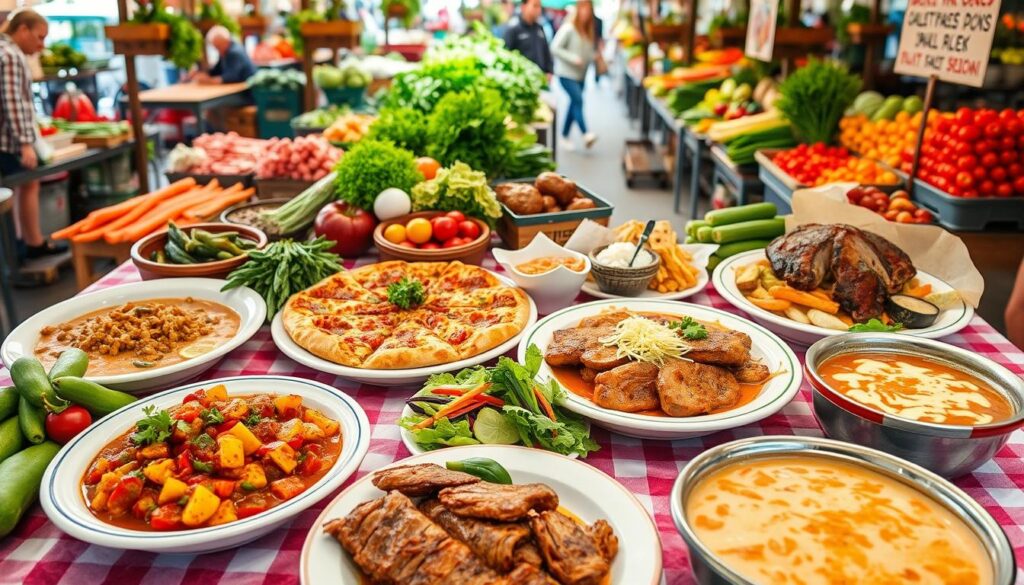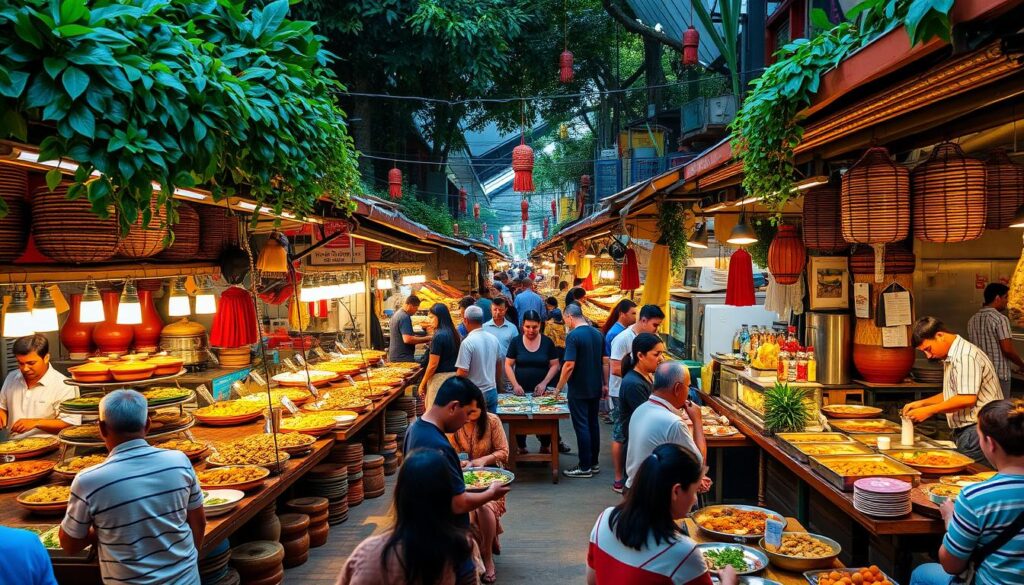When traveling, one of the best ways to experience the local culture is through local food experiences, which offer a unique perspective on the culture and people of a place, allowing you to immerse yourself in authentic culinary adventures and savor the best local eats1. Local food is often the cheapest option for travelers on a budget, and for backpackers, street food is typically cheaper than cooking for oneself, maximizing budget efficiency1. You can enjoy local food experiences when traveling, which provide an opportunity to try authentic culinary adventures and discover the best local eats.
As you explore local food experiences, you’ll find that eating in local markets often offers the freshest ingredients as locals buy their food there, and countries known for specific drinks reflect the global diversity in beverage offerings and tasting experiences1. The presence of Michelin Star restaurants and unique dining experiences enhances the culinary travel market, and special dietary needs can significantly complicate dining options when traveling1. You can have local food experiences when traveling, which include authentic culinary adventures and the best local eats, allowing you to experience the local culture.
Key Takeaways
- Local food experiences offer a unique perspective on the culture and people of a place.
- Local food is often the cheapest option for travelers on a budget1.
- Eating in local markets often offers the freshest ingredients1.
- Countries known for specific drinks reflect the global diversity in beverage offerings and tasting experiences1.
- Special dietary needs can significantly complicate dining options when traveling1.
- Local food experiences provide an opportunity to try authentic culinary adventures and discover the best local eats.
Discovering Authentic Culinary Cultures
As you embark on your journey to explore local food experiences, you’ll find that food tourism is an excellent way to immerse yourself in the culture of a place. Tasting local cuisine is not just about savoring flavors, but also about understanding the traditions and values behind the food2. By engaging with local chefs and participating in cooking classes, you can gain a deeper appreciation for the culinary heritage of a region.
Immersive dining experiences can be found in various forms, from street food markets to traditional family-owned restaurants. For instance, a cooking class in Mexico City can teach you how to make traditional dishes like tacos and mole, while a food tour in San Francisco can introduce you to the city’s diverse culinary scene, from Chinese to Italian cuisine2. These experiences allow you to connect with the local community and learn about their customs and traditions.
Some of the benefits of food tourism include supporting local economies and promoting cultural exchange. By choosing to dine at smaller, farm-to-table restaurants, you can help reduce the carbon footprint of your travels and contribute to the preservation of local culinary traditions3. Additionally, engaging with local food cultures can enrich your travel experience and provide lasting memories.
To make the most of your food tourism experience, consider the following tips:
- Research local culinary specialties and traditional dishes
- Engage with local chefs and food vendors to learn about their cooking techniques and ingredients
- Participate in cooking classes or workshops to gain hands-on experience
- Support local restaurants and food establishments to promote cultural exchange and economic growth
By following these tips, you can have a more immersive and meaningful food tourism experience, and contribute to the preservation of local culinary cultures2.
Must-Try Dishes Around the United States
As you embark on a culinary exploration of the United States, you’ll discover a diverse range of flavors of the destination, from the seafood of New England to the barbecue of the South. With 58% of Americans always on the lookout for local food experiences when traveling4, it’s no wonder that hidden food gems are waiting to be uncovered in every region.
In New England, 85% of residents consume seafood dishes, such as clam chowder and lobster rolls, regularly4. Meanwhile, in the South, Nashville hot chicken has seen a 45% increase in popularity among dish selections in Southern restaurants since 20184. As you explore the country, be sure to try iconic meals like the Philly cheesesteak, which can exceed 1 pound in serving size, making it a meal rich in calories4.
Some of the must-try dishes around the United States include:
- Seafood in New England, such as clam chowder and lobster rolls
- Barbecue in the South, including Nashville hot chicken and slow-cooked brisket
- Philly cheesesteaks in Pennsylvania, with their signature cheesesteak sandwiches
- Deep-dish pizza in Chicago, with its thick crust and melted cheese

With so many unique regional specialties to sample, your culinary exploration of the United States is sure to be an unforgettable experience. Whether you’re in the mood for seafood, barbecue, or something entirely new, the flavors of the destination are waiting to be discovered5. So why not start planning your next foodie adventure today and uncover the hidden food gems that make America’s culinary scene so diverse and exciting6?
| Region | Must-Try Dish | Description |
|---|---|---|
| New England | Clam Chowder | A creamy soup made with clams, potatoes, and onions |
| South | Nashville Hot Chicken | A spicy fried chicken dish served with local specialties |
| Midwest | Deep-Dish Pizza | A thick-crusted pizza filled with melted cheese and toppings |
The Art of Food Festivals
As you explore the local food scene, you’ll discover that food festivals are a great way to celebrate seasonal flavors and meet local artisans and producers. These events bring together a variety of local food vendors, from artisanal cheese makers to craft brewers, offering a unique perspective on the local cuisine7. For instance, the annual Food Festival in San Francisco features a range of local food vendors, allowing attendees to sample a variety of dishes in one event, fostering a broader culinary appreciation7.
When attending food festivals, you can expect to find a range of activities, including tastings, workshops, and masterclasses. These events provide an opportunity to learn about sustainable practices, enhancing your culinary knowledge7. Some notable food festivals include the EPCOT International Food & Wine Festival, which features more than 25 marketplaces, and the Jackson Hole Food & Wine Festival, which showcases the local culinary scene and draws big-name chefs8.
Here are some benefits of attending food festivals:
- Sampling a variety of local dishes in one event, fostering a broader culinary appreciation7
- Learning about sustainable practices, enhancing your culinary knowledge7
- Meeting local artisans and producers, supporting the local economy9
- Engaging with local communities and culinary traditions, enhancing your travel experience9
Overall, food festivals are a fun and delicious way to experience the local food scene, with many cities and towns hosting their own unique events throughout the year. By attending these events, you can celebrate seasonal flavors, meet local artisans and producers, and enhance your culinary knowledge, all while supporting the local economy9.
| Festival | Location | Description |
|---|---|---|
| EPCOT International Food & Wine Festival | Florida | Features more than 25 marketplaces |
| Jackson Hole Food & Wine Festival | Wyoming | Showcases the local culinary scene and draws big-name chefs |
| Aspen Food & Wine Classic | Colorado | Hosts thousands of culinary enthusiasts each year |
Cultural Dining Experiences
When it comes to cultural dining experiences, traditional restaurants and unique dining concepts are a great way to immerse oneself in the local culture10. According to recent data, approximately 30% of Airbnb experience bookings fall under the ‘food and drink’ category10, indicating a growing interest in culinary experiences. This trend is also reflected in the fact that 50% of global travelers book restaurant reservations before their flights11.
A key aspect of cultural dining experiences is the opportunity to try traditional cuisine, which can be found in traditional family-owned restaurants. These establishments often serve as a window into the local culture, offering a taste of traditional dishes and drinks. On the other hand, unique dining concepts, such as supper clubs, can provide a fun and innovative way to experience the local food scene12. For instance, 47% of travellers are motivated to travel for unusual dining experiences12, highlighting the importance of unique dining concepts in cultural dining experiences.
Some popular cultural dining experiences include:
- Traditional Italian restaurants in New York City’s Little Italy
- Supper clubs with a focus on local and seasonal ingredients
- Cooking classes that teach traditional cooking methods and recipes
These experiences allow travelers to engage with local cultures through culinary experiences, which is a key aspect of cultural dining experiences11. With the rise of culinary travel, it’s no wonder that cultural dining experiences are becoming increasingly popular, with 88% of affluent travelers considering the opportunity for new food experiences as either “important” or “very important” when choosing a destination11.

Eating Your Way Through Food Tours
When it comes to exploring the local food scene, food tours are a great way to experience the unique flavors of a city. With many cities offering guided culinary adventures, you can discover the best neighborhood flavors and hidden gems that only a local would know13. From sampling local delicacies to learning about the history and culture behind the food, food tours provide a unique perspective on the local cuisine.
Some popular destinations for food tours include Peru, known for its unique flavors and diverse culinary heritage14, and Indonesia, which features over 485 ethnic groups, each with its own local food14. In the United States, cities like New Orleans and Chicago offer guided culinary adventures that showcase their famous Creole and deep-dish pizza cuisines13.
These food tours often include stops at local eateries, markets, and food trucks, allowing you to experience the authentic tastes and flavors of the city. With the rise of mobile apps like Yelp and TripAdvisor, it’s easier than ever to find and book food tours in your destination14. So why not embark on a guided culinary adventure and discover the unique neighborhood flavors of your next travel destination15?
By joining a food tour, you’ll not only get to taste the local cuisine, but also learn about the history and culture behind the food. Many food tours are led by local chefs and food connoisseurs, who can provide insider tips and recommendations on the best places to eat and drink13. So whether you’re a foodie or just looking for a unique experience, food tours are a great way to explore the local food scene and discover new neighborhood flavors.
Sourcing Sustainable and Organic Eats
When exploring local food experiences, seeking out sustainable and organic options is a crucial part of supporting the community and reducing your environmental impact16. By visiting local farmers’ markets, you can connect directly with producers and enjoy the freshest, locally sourced produce17. These markets often offer goods that are up to 50% fresher than what you’d find at the supermarket, thanks to the shorter supply chain17.
You can also look for farm-to-table restaurants that prioritize sustainable and organic ingredients16. These establishments often highlight grass-fed beef, organic produce, and other responsibly sourced menu items, allowing you to savor the flavors of the region while making eco-conscious choices16. By supporting these local businesses, you’re not only enjoying delicious meals but also contributing to a more sustainable food system1718. As you plan your culinary adventures, consider incorporating sustainable practices into your snacking and dining habits, such as reducing waste, consuming seasonal produce, and prioritizing local and organic options18. These small steps can make a significant impact on the environment and help you immerse yourself in the local food culture in a more meaningful way.
FAQ
What are some top local food experiences to savor on my travels?
How can I discover authentic culinary cultures when traveling?
What are some must-try dishes I shouldn’t miss around the United States?
Why are food festivals a great way to experience the local food scene?
What are some unique cultural dining experiences I can have when traveling?
How can I make the most of food tours when exploring a new destination?
Why is it important to source sustainable and organic eats when traveling?
Source Links
- Eating Local Food & Drink
- Understanding Culture through Food
- Exploring Local Food Cultures and Farm-to-Table Experiences – Planeterra
- The 35 Regional Foods to Eat on a US Road Trip | SIXT rent a car Magazine
- Traditional southern comfort, healthier California staples, America offers a range of food, flavors
- What to eat in the USA: 12 must-try foods | Intrepid Travel
- Gastronomic Experiences: Discovering Food Festivals and Local Cuisine – New York Wire
- Food Festivals Worth Traveling For | Berkley One
- What is Food / Culinary Tourism and Why is it so Important?
- What is food tourism and why is it growing in popularity? – The Travel Psychologist
- 2025 TRAVEL TRENDS: Eating your way around the world | Spa Executive
- A taste of culture: New food tourism rooted in experiences | Dineplan Blog
- Food tours with locals | Eatwith
- Food Tourism: The Pursuit and Pleasure of Eating and Drinking
- Will travel for food – A food lover’s guide to the galaxy
- Sustainable Travel: Real Food on the Road
- Eco-Friendly Eats: How to Support Sustainable Food Choices While Travelling – Conversant Traveller
- Travelers Want Sustainable Food In 2024. Here’s How They’re Getting It.








